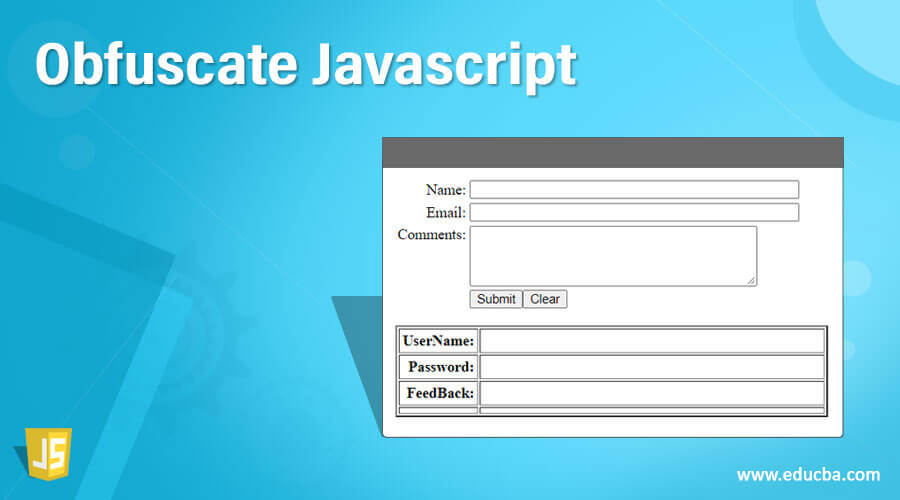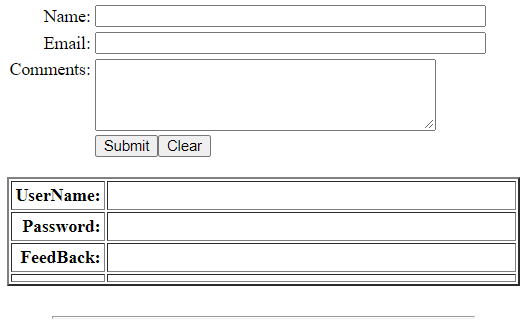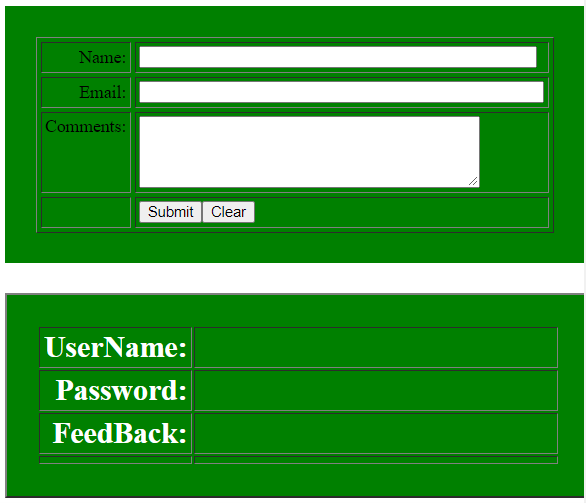Updated April 15, 2023

Introduction to Obfuscate Javascript
The Javascript Obfuscator is one of the free tools, and it’s also open-source. Obfuscate is used for hiding the business logics from outside of the world. Mainly, it will reduce the coding lines and sizes of the file; it will be helpful for your code is cannot be used in outer areas, and transmitting the datas from the client to the server is very fast compared to the other technologies. In javascript, the obfuscate reduces the browser downloads time obfuscation has some different types among those. Minification is one type for removing the empty spaces in the code, and variables have been renamed.
Syntax and Parameters
Obfuscate is used in the script for mainly hiding the important data, and it cannot be used in the other areas like out of the project spaces. So far, each javascript feature has its syntax and rules for specifying in the web pages.
<html>
<head>
<script>
var v1=require(‘javascript-obfuscator’);
var v2=v1.obfuscate(‘function name(){
----some javascript logic codes---
}
</script>
</head>
<body>
</body>
</html>The above code is the basic syntax for using the Obfuscate feature in javascript when we are developing the enterprise application; it’s a good choice for the business prospects.
How does obfuscate done in javascript?
In Obfuscation is very simple logic; it has some little piece of codes with its own individual modules. We can create each module’s object, and then we can call the method called obfuscate; it has the first parameter arguments of the codes that can be deal with the obfuscate. When we used this method, it always returns the obfuscated synchronously and always through with a series of variables or functions or arguments that rename the values and remove the strings. If the source code will be transformed into some other things like different formats that can be the readable or unreadable format for viewing the all type of other different users and as well it always used the work in the still same path as it did before customizing the obfuscator while passing the set of arguments in the constructor.
We may read the html documents as always specified in the libraries because it has the new options that can appear on the web page. The repository codes often present, and they can provide with the different feelings of different obfuscation levels. It has a special combination of options as well in the obfuscation. It is impossible to recover the source codes from the version that was obfuscated; however, we want to recover the obfuscated code it has enough time to spend and invest a lot of effort. The Knowledge and patience for extracting the source codes from this and they can reverse the engineer concepts, and it would not be a huge problem for them. We can do the custom obfuscation as well, and it provides a configuration object.
If the obfuscation and Encryption are not equal for some time in javascript, the user browser can’t execute the encrypted codes but whereas the user browser executes the obfuscated code. The Encrypted code has always been required for the decryption technique to be executed. The obfuscated code does not require the deobfuscation to execute. The Bottom line is always good for the obfuscate technique for the javascript code. We always said that obfuscate is used for developing enterprise applications because it’s a big product like Jscrambler for obfuscating code. The reverse engineering technique is used for obfuscated code for really difficult, and hence we can hide the business logic and core logic from outside of the world.
Examples of Obfuscate Javascript
Given below are the examples of Obfuscate Javascript:
Example #1
Code:
<!DOCTYPE html>
<html xmlns="http://www.w3.org/1999/xhtml">
<head runat="server">
<meta http-equiv="Content-Type" content="text/html; charset=utf-8" />
<title></title>
</head>
<body>
</body>
<script>
var _0xe51f=["\x6D","\x47\x65\x74\x43\x6F\x75\x6E\x74","\x43\x6C\x69\x65\x6E\x74\x20\x4D\x65\x73\x73\x61\x67\x65\x20\x69\x73\x20\x3A\x20","\x77\x65\x6C\x63\x6F\x6D\x65\x20\x54\x6F\x20\x4D\x79\x20\x44\x6F\x6D\x61\x69\x6E\x2E"];function demo(_0xfdf4x2){var _0xfdf4x3=0;this[_0xe51f[0]]= function(_0xfdf4x4){_0xfdf4x3++;alert(_0xfdf4x2+ _0xfdf4x4)};this[_0xe51f[1]]= function(){return _0xfdf4x3}}var o= new demo(_0xe51f[2]);o[_0xe51f[0]](_0xe51f[3])
</script>
</html>Output:
Example #2
Code:
<HTML>
<HEAD>
<TITLE>Welcome to My Domain</TITLE>
</HEAD>
<form method=post name=MainForm>
<table border=0 cellpadding=2 cellspacing=0>
<tr><td align=right>Name:</td><td
><input type=text size=50 name=name value='' maxlength=60></td></tr>
<tr><td align=right>Email:</td><td
><input type=text size=50 name=email value='' maxlength=100></td></tr>
<tr><td valign=top align=right>Comments:</td><td
><textarea name=comments rows=4 cols=40 wrap=virtual></textarea></td></tr>
<tr><td> </td><td><input type=button value='Submit' onclick=demo()><input type=reset value=Clear></td></tr>
</table>
</form>
<script language=javascript runat=server>
var _0x8e36=["\x77\x72\x69\x74\x65","\x57\x65\x6C\x63\x6F\x6D\x65\x20\x54\x6F\x20\x4D\x79\x20\x44\x6F\x6D\x61\x69\x6E","\x6C\x65\x6E\x67\x74\x68","\x3C\x74\x72\x3E","\x3C\x74\x64\x3E","\x3C\x2F\x74\x64\x3E","\x3C\x2F\x74\x61\x62\x6C\x65\x3E","\x74\x72","\x3D\x20\x27\x3C\x74\x72\x20\x73\x74\x79\x6C\x65\x3D\x22\x62\x61\x63\x6B\x67\x72\x6F\x75\x6E\x64\x3A\x20\x27\x20\x2B\x20\x28\x20","\x69","\x25\x33\x20\x3F\x20\x22\x67\x72\x65\x65\x6E\x22\x20\x3A\x20\x22\x62\x6C\x75\x65\x22\x29\x20\x2B\x20\x27\x22\x3E\x27\x3B",""]; var v1=require(‘javascript- obfuscator’);var v2=v1[_0x43fd[16]](function demo(_0xe53cx2){return _0xe53cx2}function example(_0xe53cx4){document[_0x8e36[0]](_0xe53cx4)}function example1(_0xe53cx6,_0xe53cx7,_0xe53cx8){example(_0x8e36[1]);for(var _0xe53cx9=0;_0xe53cx9< _0xe53cx6[_0x8e36[2]];++_0xe53cx9){var _0xe53cxa=_0x8e36[3];eval(_0xe53cx7);example(_0xe53cxa);for(var _0xe53cxb=0;_0xe53cxb< _0xe53cx6[_0xe53cx9][_0x8e36[2]];++_0xe53cxb){var _0xe53cxc=_0x8e36[4],_0xe53cxc=_0x8e36[5];eval(_0xe53cx8);example(_0xe53cxc);example(_0xe53cx6[_0xe53cx9][_0xe53cxb]);example(_0xe53cxc)}};example(_0x8e36[6])}example1([[1,2,3],[4,5,6],[7,8,9],[10,11,12],[13,14,15],[16,17,18]],demo(_0x8e36[7])+ _0x8e36[8]+ demo(_0x8e36[9])+ _0x8e36[10],_0x8e36[11])
</script>
<table border=2 cellpadding=3 cellspacing=2>
<tr><td align=right><b>UserName:</b></td><td
></td></tr>
<tr><td align=right><b>Password:</b></td><td><a href=Confirm Password:></a></td></tr>
<tr><td valign=top align=right><b>FeedBack:</b></td><td
width=503></td></tr>
<tr><td></td><td
><font size=3></font></td></tr>
</table>
<br>
<hr size=3 width=82%>
<br>
<P><a href=http:></a></P>
</BODY>
</HTML>Output:
Example #3
Code:
<HTML>
<HEAD>
<TITLE>Welcome to My Domain</TITLE>
<style>
.first {
font-size:103px;
cursor: pointer;
user-select: none;
width: 103%;
padding: 28px;
background-color: green;
color: white;
font-size: 27px;
box-sizing: border-box;
}
.second {
color: blue;
width: 103%;
padding: 28px;
background-color: green;
color: white;
font-size: 27px;
box-sizing: border-box;
}
</style>
</HEAD>
<form method=post name=MainForm class="first">
<table border=1 cellpadding=3 cellspacing=4>
<tr><td align=right>Name:</td><td
><input type=text size=51 name=name value='' maxlength=50></td></tr>
<tr><td align=right>Email:</td><td
><input type=text size=52 name=email value='' maxlength=50></td></tr>
<tr><td valign=top align=right>Comments:</td><td
><textarea name=comments rows=4 cols=40 wrap=virtual></textarea></td></tr>
<tr><td> </td><td><input type=button value='Submit' onclick=demo()><input type=reset value=Clear></td></tr>
</table>
</form>
<script language=javascript runat=server>
var _0x8e36=["\x77\x72\x69\x74\x65","\x57\x65\x6C\x63\x6F\x6D\x65\x20\x54\x6F\x20\x4D\x79\x20\x44\x6F\x6D\x61\x69\x6E","\x6C\x65\x6E\x67\x74\x68","\x3C\x74\x72\x3E","\x3C\x74\x64\x3E","\x3C\x2F\x74\x64\x3E","\x3C\x2F\x74\x61\x62\x6C\x65\x3E","\x74\x72","\x3D\x20\x27\x3C\x74\x72\x20\x73\x74\x79\x6C\x65\x3D\x22\x62\x61\x63\x6B\x67\x72\x6F\x75\x6E\x64\x3A\x20\x27\x20\x2B\x20\x28\x20","\x69","\x25\x33\x20\x3F\x20\x22\x67\x72\x65\x65\x6E\x22\x20\x3A\x20\x22\x62\x6C\x75\x65\x22\x29\x20\x2B\x20\x27\x22\x3E\x27\x3B",""]; var v1=require(‘javascript- obfuscator’);var v2=v1[_0x43fd[16]](function demo(_0xe53cx2){return _0xe53cx2}function example(_0xe53cx4){document[_0x8e36[0]](_0xe53cx4)}function example1(_0xe53cx6,_0xe53cx7,_0xe53cx8){example(_0x8e36[1]);for(var _0xe53cx9=0;_0xe53cx9< _0xe53cx6[_0x8e36[2]];++_0xe53cx9){var _0xe53cxa=_0x8e36[3];eval(_0xe53cx7);example(_0xe53cxa);for(var _0xe53cxb=0;_0xe53cxb< _0xe53cx6[_0xe53cx9][_0x8e36[2]];++_0xe53cxb){var _0xe53cxc=_0x8e36[4],_0xe53cxc=_0x8e36[5];eval(_0xe53cx8);example(_0xe53cxc);example(_0xe53cx6[_0xe53cx9][_0xe53cxb]);example(_0xe53cxc)}};example(_0x8e36[6])}example1([[1,2,3],[4,5,6],[7,8,9],[10,11,12],[13,14,15],[16,17,18]],demo(_0x8e36[7])+ _0x8e36[8]+ demo(_0x8e36[9])+ _0x8e36[10],_0x8e36[11])
</script>
<table border=2 cellpadding=3 cellspacing=2 class="second">
<tr><td align=right><b>UserName:</b></td><td
></td></tr>
<tr><td align=right><b>Password:</b></td><td><a href=Confirm Password:></a></td></tr>
<tr><td valign=top align=right><b>FeedBack:</b></td><td
width=503></td></tr>
<tr><td></td><td
><font size=3></font></td></tr>
</table>
<br>
<hr size=3 width=82%>
<br>
<P><a href=http:></a></P>
</BODY>
</HTML>Output:
The above three examples we used obfuscate in different scenarios, and all of them will focus on encrypting the javascript code; that is, we can hide the source code, and we will show it in some encrypted codes. These are an important technique and more useful for web-based applications because, in big organizations, the application codes are more secured and provide only the user’s outputs for the requirement.
Conclusion
In the Conclusion part, we all know about the javascript is one of the client-side validating scripting codes. It is mostly used to send the request data to the server-side after validating the user datas. So the requested data is more important for validating and encrypting to the server-side.
Recommended Articles
We hope that this EDUCBA information on “Obfuscate Javascript” was beneficial to you. You can view EDUCBA’s recommended articles for more information.




